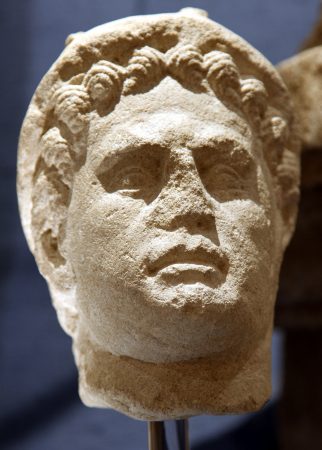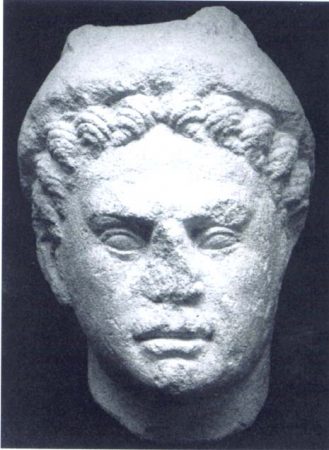Bea H and Ruth W are two secondary school students, completing their Bronze Duke of Edinburgh volunteer work. They both enjoy history lessons at school and wanted to learn more about the history of their hometown, Cirencester. So, they have created this blog as a part of their volunteer work for the Corinium Museum.
A small, limestone statue head, produced in the Romano British period, that belongs to the Roman God Mercury, was found on Cricklade Street. It now sits proudly in the Corinium Museum; read on to discover more.


Limestone is a sedimentary rock, and it is composed of many different minerals. Limestone would have been used because it is easy to shape; a lovely colour and the local stone. This sculpture was made using carvings and the calcium carbonate in the stone appears chalky and powdery making it very soft which is why it is such a good material and would explain why it was used in the Roman times. They also used limestone as their version of concrete, by heating it 900 degrees Celsius. As well as this, the Cotswold area has a noticeable amount of housing made from limestone as it is very commonly found around here which explains why this statue was discovered in Cirencester. There is some evidence to suggest that these sculptures could have been painted, although no paint has survived on the statues over time.
Mercury is the Roman equivalent of the Greek God Hermes and the messenger to all the gods. He is depicted with winged feet and a winged helmet. He is also the God of translators and has incredible wisdom. He is a symbol of wealth and good fortune as well as fertility. This would have been considered particularly important to Romans, hence why his statue would have wanted to have been displayed. The fact that he symbolizes good fortune and wealth made him a common statue for Romans to want. The planet Mercury is named after this Roman God because it is the smallest planet that moves very quickly around the sun.
The object would have been carved using hammers and chisels. A finer tipped chisel would have been used to get all the details in the face. This object was made in the Romano-British period which happened between 43 to 410 AD. The statue would have been most likely made in the second to third century because that is when the town was occupied. There were many Roman artists who would make many sculptures such as this one. Sculpture during this time period progressed slightly from Greek sculpture as Roman artists looked at working with light and making sculpture even more realistic.
This statue of Mercury would have been displayed in several places including, public buildings, public parks, and private homes and gardens. They were important to Romans in their daily lives. Roman sculpture was heavily influenced by Greek sculpture and in fact many were just copies of the Greeks. The wealthier Romans would have decorated their large homes with pieces of art like this and a lot of them were either for themselves or their ancestry still to come. It was quite common to have sculptures of gods in houses as mythology played an important role in their lives which is why this sculpture of Mercury would have been very popular. Statues and sculptures would have also commonly depicted imagery of philosophers, famous athletes and successful generals. Statues of the heads were known as busts and many rich Romans would have put busts of their relatives in their atriums (big open roofed entrance halls).
So, there it is, everything you need to know about the limestone head of the very popular god Mercury.
By Beatrix Hart and Ruth Watt, age 14.










